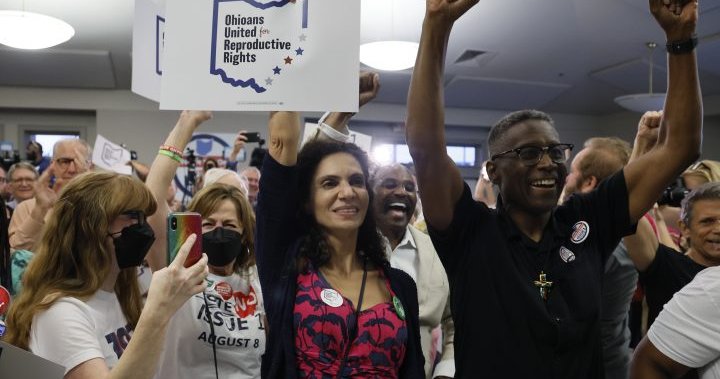Ohio voters decisively rejected a Republican-sponsored measure on Tuesday that aimed to raise the bar for changing the state’s constitution, paving the way for a fall campaign that will serve as the nation’s latest referendum on abortion rights following last year’s Supreme Court ruling. The defeat of Issue 1 means that future constitutional amendments will still only require a simple majority to pass, rather than a proposed 60% supermajority. Proponents of the measure argued that the higher threshold would safeguard the state’s foundational document from outside interest groups.
Opposition to the proposal was widespread, breaking party lines and extending even into traditionally Republican territory. In fact, early returns showed that support for the measure fell far below former President Donald Trump’s performance in the 2020 election in nearly every county. Dennis Willard, a spokesperson for the opposition campaign One Person One Vote, described Issue 1 as a “deceptive power grab” intended to diminish the influence of Ohio voters. He celebrated the victory for democracy, stating that “the majority still rules in Ohio.”
President Joe Biden applauded the result, declaring in a statement that “this measure was a blatant attempt to weaken voters’ voices and further erode the freedom of women to make their own healthcare decisions. Ohioans spoke loud and clear, and tonight democracy won.” Susan B. Anthony Pro-Life America, a national group opposing abortion rights, expressed disappointment with the result and criticized the outside funding that supported the opposition, disregarding that both sides relied on national groups and individuals in their campaigns.
Republican lawmakers behind the measure attributed its defeat to insufficient time to explain its merits to voters, expressing disappointment that Republicans did not unite on the issue. Republican House Speaker Jason Stephens urged supporters to move past the results and focus on defeating the fall abortion rights measure. Although abortion was not directly on the special election ballot, the outcome represents another setback for Ohio Republicans who advocate for strict restrictions on the procedure. The question was added to the summer ballot to weaken the citizen initiative that will be decided in November, seeking to enshrine abortion rights in the state.
A coalition advancing the fall abortion question believed that the defeat of Issue 1 would enable them to secure passage in November. Interest in the special election was high, despite Republicans disregarding their own law to place the question before voters in August. Early voter turnout was significantly higher than usual, particularly in Democratic-leaning counties around Cleveland, Columbus, and Cincinnati.
The opposition campaign, One Person One Vote, united voting rights, labor, faith, and community groups. It also garnered support from four living ex-governors and five former state attorneys general from both parties, who criticized the proposed change as bad public policy. The simple majority standard, in effect since 1912, presents a more surmountable hurdle for Ohioans for Reproductive Rights, the group advancing the abortion rights amendment for November. This amendment aims to establish a “fundamental right to reproductive freedom” with “reasonable limits.” According to AP VoteCast polling, 59% of Ohio voters believe abortion should generally be legal.
Critics of the measure, like Columbus resident Eric Chon, accused Republicans of having an anti-abortion agenda and of changing the rules whenever something doesn’t go their way. The election’s outcome took place during an August special election, a type that Republican Secretary of State Frank LaRose had previously deemed undemocratic due to historically low turnout. Republican lawmakers had even passed a law last year to mostly eliminate special elections, which they ignored for this year’s election.
Al Daum, a resident of Hilliard, supported the special election measure, believing that it would give more Ohio residents a chance to have their voices heard. Along with raising the threshold to 60%, the measure would also require signatures for a constitutional amendment to be collected from all 88 counties in Ohio, rather than just 44.
The rejection of the proposal represents a rare defeat for Ohio Republicans, who have held power across all branches of state government for the past 12 years. GOP lawmakers justified the higher threshold by citing potential future amendments related to gun control and minimum wage increases. The campaign Protect Ohio Women, which aims to defeat the fall abortion rights amendment, vowed to continue fighting in the coming months, asserting that their pro-life, pro-parent coalition is more motivated than ever.
Denial of responsibility! VigourTimes is an automatic aggregator of Global media. In each content, the hyperlink to the primary source is specified. All trademarks belong to their rightful owners, and all materials to their authors. For any complaint, please reach us at – [email protected]. We will take necessary action within 24 hours.


